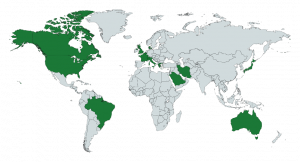4 Incorporating Internationalization in STEM
Dr. Diba Mani
Course: Neuromuscular Aspects of Exercise (APK 4115)
Description
Given the coursework demanded in most STEM programs, including those at UF, students majoring in only a STEM degree program are typically not able to take many (sometimes any!) courses that expose them to cultures or countries. However, global engagement at the undergraduate level can instill skills and experiences that our students will need to succeed in their careers. Especially in our current climate, it is vital that we promote well-roundedness in our students and ourselves, which includes awareness of other perspectives.
Assignment Goals/Outcomes
This method of active learning and internationalization helped meet three student learning objectives linked to broad competencies in global awareness and intercultural communication, as described by the UF Quality Enhancement Plan: (1) content, (2) critical thinking, and (3) communication.
Assignment Setup (Instructor)

Prior to the start of the semester, I reached out to researchers from around the world who had authored an original research paper on a topic relevant to course content. Each researcher agreed to a virtual interview with a small group of students at some time during the upcoming semester. After reading and dissecting their assigned paper, students emailed their researcher to schedule a video interview. In the video interview, students asked questions they had prepared regarding the content within the paper they’d read, academia abroad, and the researcher’s own background. To culminate the project, students presented a summary on the research paper and shared key aspects of their interview with their classmates. These presentations were successful both when given in-person on campus and virtually via Zoom, following the transition online due to the emergence of COVID-19 in the U.S.
Student Instructions
A clear rubric was developed and shared at the start of the semester. Advice and sample presentations and questions were provided after a lecture on effective scientific presentations. The papers were assigned within the first week of the course. Students are advised to begin working on their presentations and interviews from the beginning; presentations begin a few week later. I prefer to have presentations 1-2 times per week; other instructors may select a couple days or weeks at the end of the semester for all presentations. Both methods have benefits.
Students follow the structure of the paper to present slides via PowerPoint, and follow suggested guidelines to contact their researcher for their virtual interview. This cumulates into a live presentations to the instructor and peers. Sometimes, the author interviewed also sits in – this is up to the presenting group and author.
The timeline (duration) and required content is discussed upfront during rubric development and presentation of said rubric.
Grading (Instructor/TA)
Students were graded based on the rubric. Pending student vote at the start of the term, peer evaluation was received on the same rubric, without specific point value allocations. Audience members were asked to provide comments on pros/cons of the presenting group’s material. The instructor took these into account when anonymously sharing peer comments and the final grade with the presenting group.
Tips and Suggestions for Instructors
- Start with smaller classes. This activity requires a lot from the instructor, at least up front. Be inclusive in your expectations and diverse in the researchers selected.
- Rather than interviews, a simpler implementation would be to include a component in the literature presentations that simply asks the presenting group to present about a different research lab, ideally somewhere else in the lab. Simply introducing the authors and explaining a bit about their background (i.e. institutions) can be significant – I do this in my APK 3200 course, where students are often just getting introduced to scientific presentations at the University level.
Keywords: STEM, global awareness, intercultural communication, virtual, researchers, interview, communication
